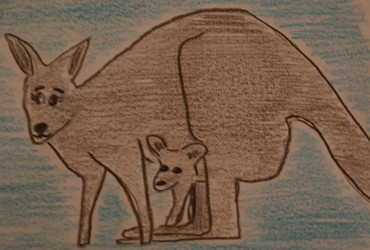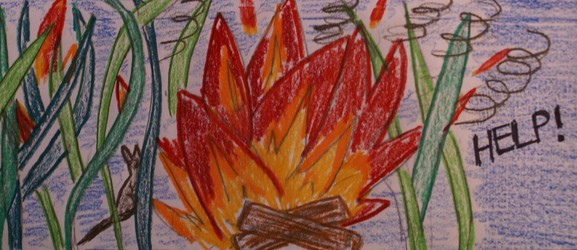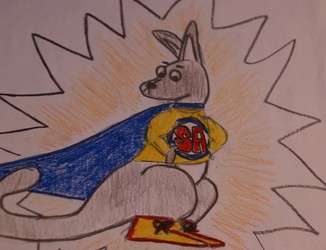General Description and Characteristics
The Eastern Grey Kangaroo, being slightly smaller than the red kangaroo, is steel grey in colour on the top, with the underside of the tail and front being lighter in colour. It has a small head with large ears and a very long tail. The kangaroo has a very hairy muzzle with fine hairs between the nostril and upper lip. They reach up to 7 feet tall and 120 lbs in weight. The Eastern Grey Kangaroos are grazing animals, with grasses as their preferred food. They typically rest in the shade during the day and feed in the late afternoon or early morning.
Adaptations to the Environment
The Eastern Grey Kangaroos have many specific adaptations to help them better survive in their habitat. They have a long tail used to balance and as a prop for standing up. They have four limbs, the front being much smaller than the hind legs. Their hands have five digits, making it easy to grasp objects. The kangaroos have an excellent sense of smell, sight, and hearing. They are able to swivel their ears around to focus on a specific direction, which helps them detect predators before they are able to see them. Their powerful hind legs allow them to reach speeds of up to 56 km/hour, travel long distances, and jump to heights of 10 feet and lengths of 26 feet. The females have a pouch in front where they are able to protect the joeys (babies) from predators. When the kangaroos sense danger, they will thump the ground with their hind legs to warn the rest of the mob.


An Eastern Grey Kangaroo running through a field. Its powerful legs enable it to travel long distances and reach speeds of up to 56 km/h. © Katie Grandis.
Classification
- Kingdom: Animalia
- Phylum: Chordata
- Class: Mammalia
- Order: Diprotodontia
- Family: Macropodidae
- Genus: Macropus
- Species: Macropus giganteus
Habitat
The Eastern Grey Kangaroo lives in the eastern parts of Australia and Tasmania, on the inland plains and along the coast. They live in mobs in the grasslands or in open woods. The mature males, the mob leaders, live with 2-3 younger males and 2-3 younger females with their joeys. These mobs generally graze together.
Reproductive Characteristics
The peak breeding time for the Eastern Grey Kangaroo is during the summer months, and the gestation period (the carrying of an embryo or fetus) generally takes about 36 days. When born, a joey climbs into the mother's pouch and attaches itself to one of four teats. There it will remain for about 300 days. The mother is still able to mate while the joey is in the pouch, but fertilized eggs cannot develop until it leaves. Males generally reach sexual maturity at 20 months while females reach it at 17. These characteristics benefit the kangaroo because the mother is able to hold and protect the joey until it is old and strong enough to survive on its own. The kangaroos have few enemies except for dingos, but because they enjoy feeding in farmers' fields and jumping their fences, they are frequently shot. Because of this, the kangaroos must move quickly to avoid injury and keep their joeys from harm. The pouch provides the protection needed for the young to survive until they mature.


Here is a kangaroo with her joey. In the pouch, the joey would attach itself to one of the mother's four teats and stay there for approximately 300 days for protection. © Katie Grandis.
Importance to the Ecosystem
Because the kangaroos are grazing animals, they control the growth and spread of grasses and other foliage. This could lead to soil degradation if left unchecked, but it's not enough to consider them an ecological hazard.
Common or Endangered Species
The Eastern Grey Kangaroos are not endangered an species. There are close to 2 million in Australia and surrounding areas. They have been hunted by Australian aborigines for their fur and meat for thousands of years. Although they are not in any immediate danger of extinction, the kangaroos are now protected by law. Their population now continues to increase in size, and the hunting is monitored by the Australian government.
Super-Aussie Saves the Ecosystem
Once upon a time, in an Australian grassland far, far away, two Eastern Grey Kangaroos fell in love. They were from two different mobs and met one day grazing about a field. They got to be very close and soon fell in love. Then one starry night they got engaged! A few months later, when they were married, the two kangaroos decided it was time to have a joey. After about thirty six days of anticipation their little joey, who they named Aussie, was born! He immediately crawled into his mother's pouch and attached himself to one of her teats. Aussie stayed there for 300 days! Finally, after nearly a year, he left his mother's pouch. Aussie was steel grey in colour and had a long tail, which helped him balance. His head was small with big ears and a hairy muzzle. Like every other joey does, Aussie grew up to be seven feet tall and weigh around 120 pounds!
Eventually Aussie went on his first grazing excursion with his mob. They traveled to a far away grassland where he had never been before. Everyone slowly grazed in the grass, munching here and there, but Aussie’s parents couldn’t believe what they saw! Aussie was grazing faster than any kangaroo had ever done before! He was gobbling down the grass, faster than the speed of light. This was when his parents realized that this was his true calling! His parents sat Aussie down one day and informed him about his super-kangaroo power. Aussie had no idea that his grazing was so incredible! He was so happy and proud of his ability that whenever he went out with his mob, he would pounce around the field, joyous as could be. Years went by and Aussie decided to put his super-kangaroo abilities to good use and became Super-Aussie! Whenever an ecosystem was in danger, it was Aussie who was called to save the day! In no time at all, he would be able to control the overgrown grass along with other types of foliage and save the lives of many small herbivores. All the male kangaroos wanted to be him, and all the female kangaroos wanted to call him theirs. He was admired and looked up to by all. Well, all but one.


Aussie was able to graze faster than any of the other kangaroos! Grazing is of great importance to the ecosystem as it controls the growth of the grass as well as other foliage. © Katie Grandis.
The big, mean, selfish herbivore loved when the grass grew long because the smaller herbivores couldn’t eat it. This allowed him and his species to have a much larger variety of grass to choose from, and they never went hungry. So whenever mobs of kangaroos came grazing, they would control the growth of the grass and other foliage. He was left having to share with the other herbivores. So one day, he decided to do something about it! The big, bad herbivore set up a trap to capture all of the kangaroos and stop them from eating his grass! He planted his magic extra grow grass, which grew a hundred times the speed of regular grass. The kangaroos were unable to keep up with this new grass and soon became trapped in the foliage. They cried and cried and chomped and chomped but nothing they did could free them from this green monster.
The big mean herbivore then decided to have a camp fire in celebration of his recent success. He gathered up all the wood he could find and created a fire pit on the grass. He grabbed the lighter out of his back pocket and lit the wood. Before he knew what was happening flames were engulfing him. Because the kangaroos weren`t controlling the spread of the grass, fire would spread rapidly. He didn’t know what to do! There was no one that could save him because all the kangaroos were trapped in the long grass. He was all alone to fight the fire himself.


The fire spread rapidly because the kangaroos weren't controling the length of the grass. The herbivore was trapped in the fire left to fight for himself © Katie Grandis.
Aussie hadn’t had to do a lot to save Eastern Australia. It seemed to be running smoothly without his intervention. Until, using his heightened senses, he saw flames coming from miles away. He could smell the fire burning and even hear the cries of the other kangaroos. He threw on his boots and suit and became Super-Aussie! He jumped as fast as he could over towards the chaos. It was quite the trek! There were mounds of dirt, rivers and streams, forests and logs. He had to jump over a fence that was almost 10 feet tall. Finally he arrived at the site of the fire and saw that all of the kangaroos were trapped. Then out of the corner of his eye, he saw the big herbivore trapped in the fire, quivering with fear. The big herbivore cried out “I’m sorry! I didn’t mean to! I just wanted to have a campfire tonight! Help me!” Because the grass grew so long, it caught fire and spread extremely quickly. It was out of control! So Super-Aussie pulled out his ‘Fire Tamer’ and managed to put out all the fire. He broke through the wall of fire and managed to save all the creatures trapped in the grass. They were all very thankful.


Super-Aussie saved the day. He freed all of the kangaroos and even saved the life of the big bad herbivore. © Katie Grandis.
After being pulled from the grass and out of the way of any danger, the big herbivore realized he had done wrong. He apologized to the kangaroos and all the creatures whose lives he had put at risk. He then thanked Super-Aussie for saving his life. The herbivore learned that all organisms contribute to the well being of the ecosystem and that kangaroos play an important role in keeping the grass under control.
Information on the Internet
- Eastern Gray Kangaroo National Geographic. 2008. 14 Sept. 2008
- Eastern Grey Kangaroo Macropus giganteus Museum Victoria. 2007. 18 Sept. 2008
- Eastern Grey Kangaroo The Big Zoo. 2008. 18 Sept. 2008
- Eastern Grey Kangaroo The Roo Ranch. 2007. 18 Sept. 2008
- Eastern Grey Kangaroo Morris, Matthew, comp. Animals! 15 May 2003. 13 Sept. 2008



 Go to quick links
Go to quick search
Go to navigation for this section of the ToL site
Go to detailed links for the ToL site
Go to quick links
Go to quick search
Go to navigation for this section of the ToL site
Go to detailed links for the ToL site